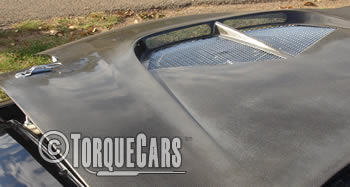Performance. Bonnet vents.
RX7 carbon bonnet vent Performance gains are possible with the addition of bonnet vents.
Heated air really does kill performance. This is due to the environment intake temperatures being hot and air at high temperatures carries less oxygen.
When driving an engine hard the under bonnet temperatures quickly build up and the engine has no choice but to suck this air in lessening your power.
It takes about 2 miles for cars engine bay to attain ambient temperatures in regular driving conditions. In stop start traffic the engine bay may never reach ambient temperatures at all.
Cold air is the friend – it carries more oxygen so incorporating vents can dramatically cool the engine bay and feed fresh cold air in the engine. Additionally, it help prevent the engine from overheating and reduced the load you happen to be putting on your engine oil.
In supercharged engines and turbo charged engines the intake air is further heated by the compression process. This heated intake air is pulled using an intercooler which helps to reduce the air charge temperatures but for this to work effectively the intercooler needs cold air flowing through it. An intercooler is simply a heat exchanger and eventually the intercooler housing will warm up (called heat soak)
Due to the large radiator placement at the front of your engine it really is quite difficult to have cold air running though the intercooler and something way round this problem is to have a top mounted intercooler with a vent cut in the bonnet. Some standard cars have this arrangement and a scoop to give the cold air with the intercooler (the Subaru Impreza for example).
Bonnet vent styles.
By putting the intercooler on the top of the feed and engine cold air through a vent in the bonnet, Intake ventSome manufacturers have got round this. Some TorqueCars members have cut vents into their bonnets as they begin to see the performance gains on offer without being interested in the styling benefits.
Bonnet vents are also popular in motor sport as well as the Mitsubishi Evo bonnet has conspicuous vents across it and the Subaru Impreza carries a top mounted intercooler using a bonnet scoop.
If a car is stationary the last thing you want is performance, the down-side of having a top-notch mounted intercooler is when the car is stationary it is actually not receiving a air flow through it but when you think it over.
Ideally the vents ought to be located
1) Near the air intake filter so cold air from the outside can be pulled in. A bit additional ducting will help channel more cold air for the filter and prevent the warm under bonnet temperatures from entering. (Avoid putting the filter in an enclosed box with cold air feeds since this will change the induction length see our cold air induction article for details.)
2) Coupled with a scoop should be placed directly over the intercooler the cold air will then enter the engine bay cooling the surrounding air and helping reduce intake temperatures.
3) Much heat comes from the exhaust part of the engine so a vent a few inches behind that area will do much to reduce the under bonnet temperature. In the event the vent is directly on top of the radiator the cooling effect will be reduced.
Supercharger vent
Vents might be cut in the bonnet but they are typically covered with a mesh of some description partly to improve appearance and partly to protect engine components from damage should a stray stone fly in its direction. Some carbon fibre bonnets have moulded vents within them and these give the best finish.
Plastic and fibreglass panels can also augment a cutout hole within a metal bonnet or hood and keep the pleasing lines and add ridges to assist airflow yet it is hard to get an easy blended finish on these stick on vents. For your hassle and time involved you are usually better off using a pre cut bonnet and fitting that instead of the standard one.
You needn’t only have vents within the bonnet you may also place them from the wing inside a BMW style shark gill vent. An effective vent design on a bonnet makes provision for both cold air to go into and a route for the heat to exit.
A raised lip can create turbulence which will help to help keep the air flowing through the engine bay. Always site the cold air intake directly below a vent because it will create a vacuum or low pressure region around it and in addition site a vent a number of inches back from the radiator and exhaust outlet.
Always add mesh behind the vent as a stone flying to the engine at high velocity can cause major problems (it may also look cool).

